#Saddleback Anemonefish
Explore tagged Tumblr posts
Text
Uncharismatic Fact of the Day
Louse got your tongue? No, it's the tongue-eating louse! As its name implies, this isopod is a parasite of fish; females latch onto a fish's tongue and cut off the blood vessels until the tongue falls off completely. The female tongue-eating louse then takes the place of the tongue, helping itself to any food that the fish might eat, as well as mucus produced in the fish's mouth.

(Image: A tongue-eating louse (Cymothoa exigua) resting on a fish's head by Marco Vinci)
Bonus image under the cut of a tongue-eating louse living up to its name!

(Image: A saddleback anemonefish (Amphiprion polymnus) carrying a tongue-biter isopod parasite (Cymothoa exigua) by Mike Veitch)
#tongue-eating louse#Isopoda#Cymothoidae#isopods#malacostracans#arthropods#uncharismatic facts#parasites
120 notes
·
View notes
Text
HEROES SPIRIT LINKS AS FISH IF HEROES SPIRIT WERE FISH
This is my mermay contribution. All characters belong to @heroesspirit!!!
Each Link has a different place in the world of cultural inspiration, so at least one of the fish included for each is endemic to that region. Endemic means it is native to that specific area and not found (naturally) anywhere else in the world!! It’s really cool. There are some fish that are endemic to a singular lake!!!! Big lakes, but still one singular lake!!!! Or one reach of a tributary stream!!! It’s super cool.
Anyway. FISH!!!!! Image descriptions at the very bottom! :D
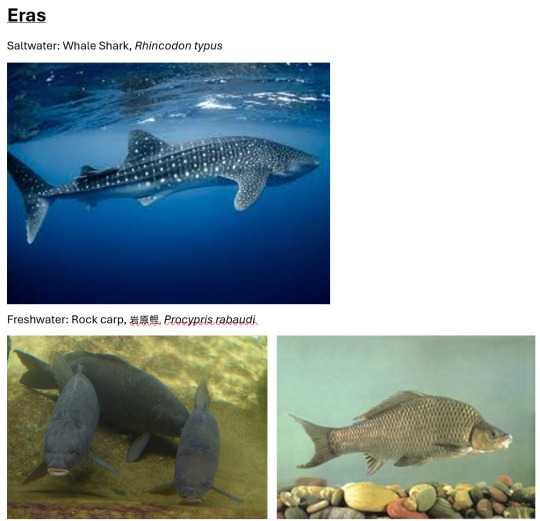
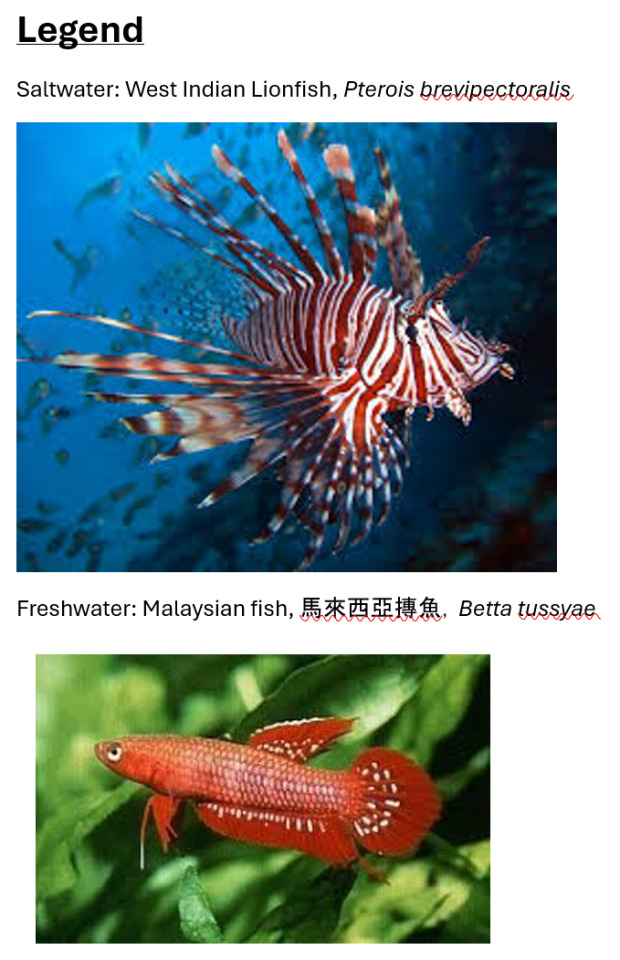
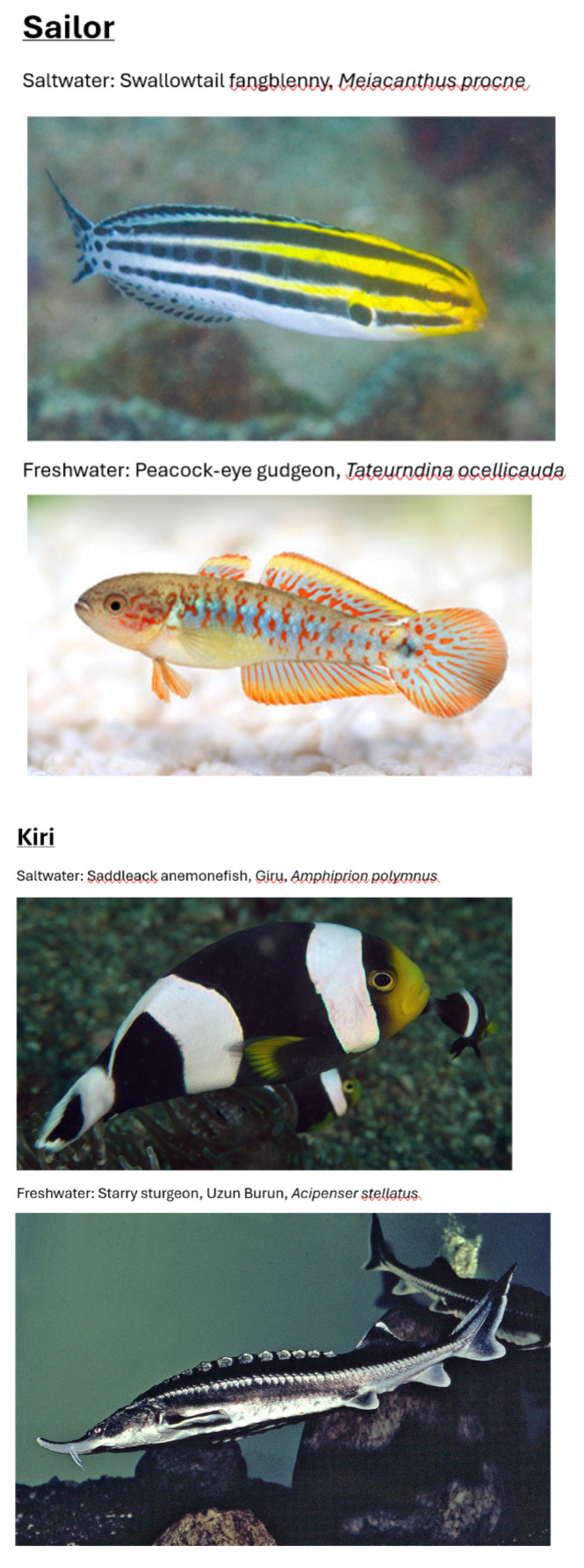
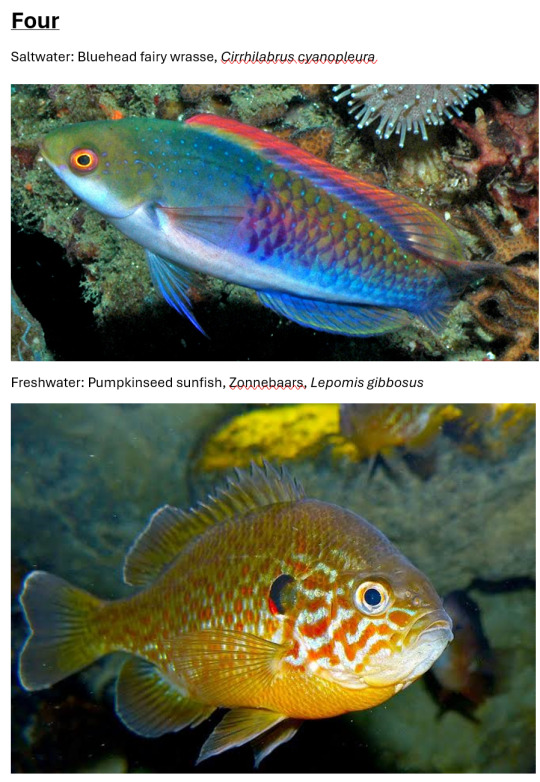
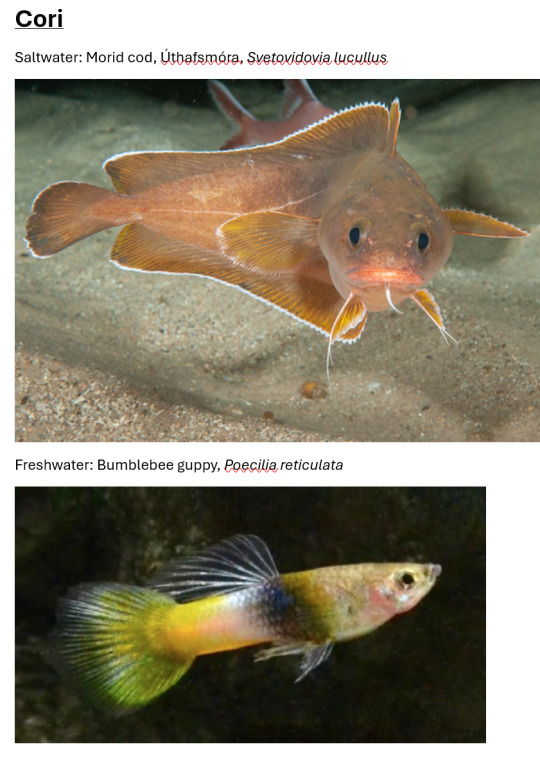
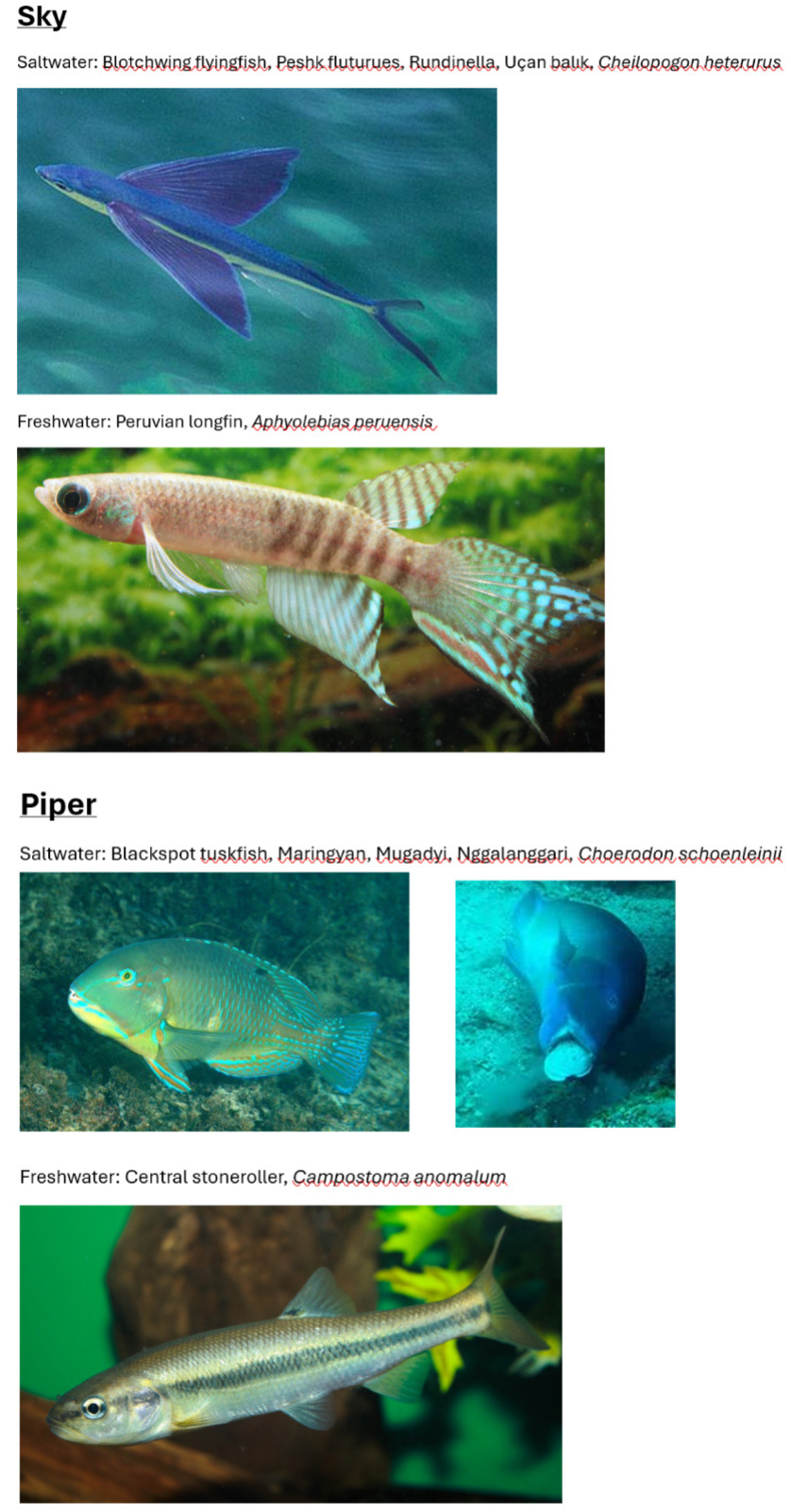
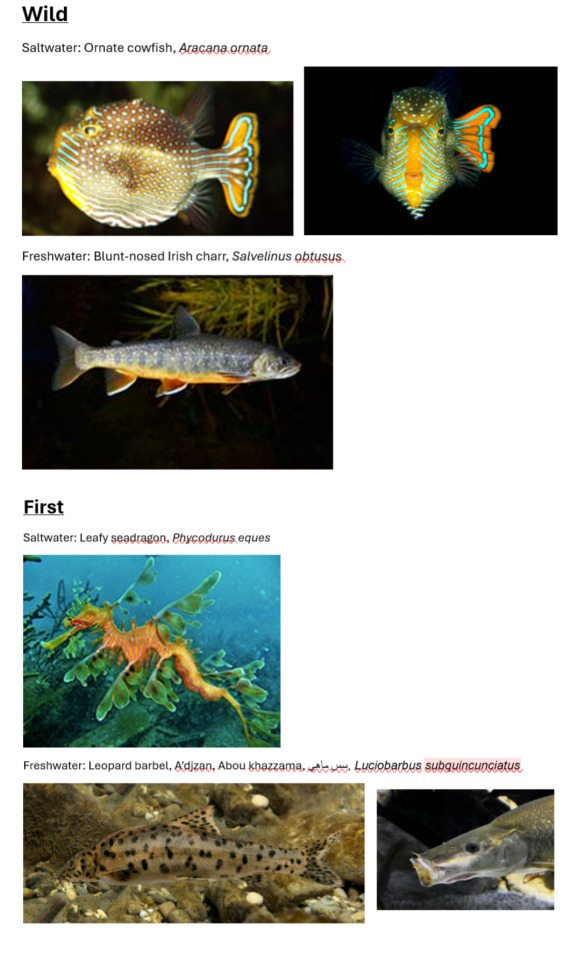
IMAGE ID: Images are the names of each link and then a saltwater fish and a freshwater fish. Each fish has the common name, the common name in the native language of wherever it is found, and then the scientific name. The fish are listed below. Since I am posting this on mobile I only have an English keyboard, so I am only including the common names in the ISO Latin alphabet in the descriptions.
Eras. Saltwater: Whale shark, Rhincodon typus. Freshwater: Rock carp, Procypris rabaudi.
Legend. Saltwater: West Indian lionfish, Pterois brevipectoralis. Freshwater: Malaysian fish, Betta tussyae.
Sailor. Swallowtail fangblenny, Meiacanthus procne. Freshwater: Peacock-eye gudgeon, Tateurndina ocellicauda.
Kiri. Saltwater: Saddleback anemonefish, Giru, Amphiprion polymnus. Freshwater: Starry sturgeon, Uzun burun, Acipenser stellatus.
Four. Saltwater: Bluehead fairy wrasse, Cirrhilabrus cyanopleura. Freshwater: Pumpkinseed sunfish, Zonnebaars, Lepomis gibbosus.
Cori. Saltwater: Morid cod, Úthafsmóra, Svetovidovia lucullus. Freshwater: Bumblebee guppy, Poecilia reticulata.
Sky. Saltwater: Blotchwing flyingfish, Peshk fluturues, Rundinella, Uçan balik, Cheilopogon heterurus. Freshwater: Peruvian longfin, Aphyolebias peruensis.
Piper: Blackspot tuskfish, Marigyan, Mugadyi, Nggalanggari, Choerodon schoeleinii. Freshwater: Central stoneroller, Campostoma anomalum.
Wild. Saltwater: Ornate cowfish, Arcana ornata. Freshwater: Blunt-nosed Irish charr, Salvelinus obtusus.
First: Saltwater: Leafy seadragon, Phycodurus eques. Freshwater: Leopard barbel, A’djzan, Abou khazzama, Luciobarbus subquincunciatus
/END ID
28 notes
·
View notes
Video
instagram
#Red #Saddleback #Anemonefish vs #Hawksbill #Turtle - I was planning to #film this Turtle munch on some #coral. Little did I know that these little anemone fish would #defend their #territory successfully. - - - #scubadiving #richelieurock #phuket #thailand #andamanislands #underwatervideography #underwaterphotography #wildlife #naturephotography #sealife #amphiprionephippium #amphiprion #ephippium (at Richelieu Rock)
#film#ephippium#richelieurock#turtle#anemonefish#defend#scubadiving#amphiprion#naturephotography#underwaterphotography#wildlife#phuket#coral#thailand#amphiprionephippium#sealife#red#saddleback#underwatervideography#territory#andamanislands#hawksbill
1 note
·
View note
Photo
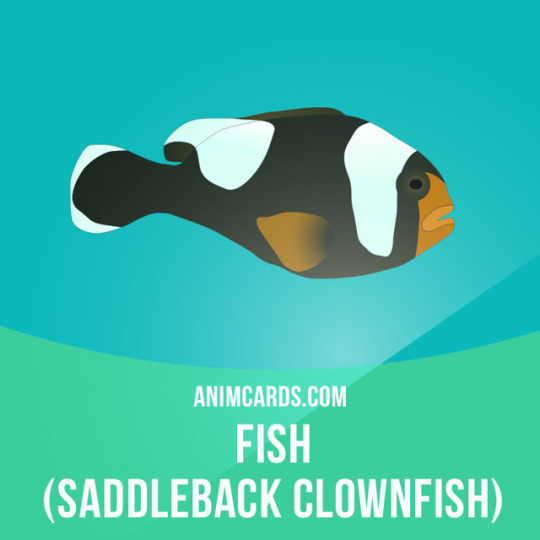
Like all anemonefishes the saddleback clownfish forms a symbiotic mutualism with sea anemones and is unaffected by the stinging tentacles of the host anemone. It has been bred in captivity. The protection of a host anemone is not required in an aquarium and attempting to keep either of the species of anemones commonly associated with this fish in a captive aquarium environment is not recommended, even for experienced aquarists.
Get our apps for learning English: learzing.com
#english#english language#learn english#english learning#study english#language#vocabulary#vocab#dictionary#animals#fish#saddleback clownfish#clownfish#anemonefish
1 note
·
View note
Photo

Juvenile red saddleback anemonefish (Amphiprion ephippium) notice that the juvenile has a white stripe over it's neck. It'll disappear with age. Taken by #Underwaterphotographer #DanielSasse #Scubadiving #Aonang #Krabi #photooftheday #Marinelifeprotection #Ouroceans #Underwaterphotography #Fortheoceans #nature #uwpic #Savetheoceans #Marineconservation #Oceandefender #Saveourseas #underwaterlife #fish #ecowarrior #wildlife #underwaterworld https://www.instagram.com/p/B0-OOcRBCni/?igshid=18b1lt9ib7a1e
#underwaterphotographer#danielsasse#scubadiving#aonang#krabi#photooftheday#marinelifeprotection#ouroceans#underwaterphotography#fortheoceans#nature#uwpic#savetheoceans#marineconservation#oceandefender#saveourseas#underwaterlife#fish#ecowarrior#wildlife#underwaterworld
1 note
·
View note
Text
Manila Ocean Park

General History of Ex-Situ Conservation site:
The park is owned by China Oceanis Philippines Incorporated, which is a subsidiary of China Oceanus Group Ltd (COG). Specializations of the company include: investment, putting up, and operation of various oceanarium attractions. After several years of experience, the group responsible for running this company now comprises of an experienced team of specialists that are experts on providing services to the developers as well as operators of different public aquarium facilities.
Conservation Strategy and Management Practices:
1. Endangered species are banned in the area.
2. Coastal resource management is being employed in places where the species found in the park are retrieved from.
3.Energy-efficiency is considered to be a priority in the running of the park’s operations
4. Those working in the park are constantly being updated regarding the threatened and endangered organisms in the country.
Some freshwater and marine organisms in the area:

1. Large Tooth Sawfish- member of a group of fish called elasmobranchs, whose skeletons comprise of cartilage. These organisms can grow up to 23 feet long and may weigh up to 1,300 pounds. They have a life span of up to 80 years.
2. Sharks- also a member of the elasmobranchs. Distinct five to seven gill slits are found to be present near the side of the head of these organisms. There are more than 465 identified species living in the marine systems as of today.
3. Stringrays- These are flattened fishes that are closely related to sharks. They have no bones present in the body. Instead, their bodies are made up of flexible cartilage. They are oviparous creatures, which means that they lay eggs and these eggs are enclosed and protected by what is known as a “mermaid’s purse.”
3. Sea Lions- sea mammals that are quadrupedals (can walk on all fours). They have external ear flaps, elongated foreflippers, short and thick hair, and a big abdomen. They are categorized under family Otariidae.
4. Jellyfish- were already present before dinosaurs even strived to live on Earth. These are jellylike creatures that move along the ocean currents and are usually abundant in cold as well as warm ocean water and even along the coastlines. They are characterized by their tiny stinging cells found in their tentacles which serve to stun the prey before devouring them.
5. Glassy Perchlet- found mainly in Asia and can grow up to 3.9cm in length. These are categorized under family Ambassidae of order Perciformes, which is the only species in the genus Chanda. They usually are found in coastal and brackish waters, and may even strive in freshwaters.
6. Common seahorse- these organisms can easily blend into their surroundings and are among the smallest seahorse species found all over the globe. What appears to be crowns located on the top of the heads of the seahorses are actually very distinct in each organism and can be likened to fingerprints of humans.
7. Starfish- They can also be called as “sea stars” and are star-shaped echinoderms under class Asteroidea. There are up to 2,000 living species of sea stars identified all over the world. Most species have five arms but some may have up to 40.
8. Clownfish- Also known as anemonefish. They belong to subfamily Amphiprioninae in the family Pomacentridae. They are known to have symbiotic mutualism relationship with the sea anemones. A popular animated movie entitled: “Nemo” is inspired by this marine organism.
9.Saddleback butterflyfish- has the scientific name: Chaetodon ephippium and resides along the Indian and Pacific Oceans from Sri Lanka, north to southern Japan, and New South Wales in Australia. What makes them unique is the presence of a large black “saddle” with white border found on its upper body.
10. Pajama Cardinalfish- also known as pajama cardinalfish, spotted cardinaldish, coral cardinalfish, and polkadot cardinalfish. This is actually a very common and popular aquarium fish. Its body comprises of a rainbow of colors and has a greenish-yellow colored face.
Trivia:
Water coming from Manila Bay is actually being filtered and used as the water source for the park’s Oceanarium. The special filtering process is being conducted so as to ensure that the quality of water is suitable for marine life.

0 notes
Text
ประเทศที่ส่งออกปลาทะเลสวย
การค้าปลาทะเลสวยงามนับว่าเป็นธุรกิจที่สร้างรายได้จำนวนมากให้กับประเทศที่มีลักษณะเป็นเกาะและมีแนวประการัง อย่างไรก็ตามปัจจุบันธุรกิจการค้าปลาทะเลสวยงามกำลังเผชิญกับปัญหาการต่อต้านจากนักอนุรักษ์สิ่งแวดล้อม เนื่องจากการจับปลาทะเลสวยงามจากธรรมชาติเป็นหนึ่งในปัจจัยที่สร้างปัญหาสภาพแวดล้อมทางทะเล ดังนั้นในปัจจุบันทางรอดของธุรกิจปลาทะเลสวยงามคือ การลงทุนวิจัยเพื่อเพาะพันธุ์และเลี้ยงปลาทะเลสวยงามในเชิงพาณิชย์
สำหรับประเทศไทยธุรกิจการค้าปลาทะเลสวยงามนั้นมีเฉพาะภายในประเทศเท่านั้น เนื่องจากไม่อนุญาตให้มีการส่งออกปลาทะเลสวยงาม อย่างไรก็ตามปัจจุบันเริ่มมีแรงผลักดันเพื่อให้มีการพิจารณาอนุมัติให้สามารถส่งออกปลาทะเลสวยงาม เฉพาะปลาทะเลสวยงามที่ได้จากการเพาะเลี้ยงในเชิงพาณิชย์และจากฟาร์มที่จดทะเบียนอย่างถูกต้องเท่านั้น ซึ่งจะทำให้มีเกษตรกรเข้ามาลงทุนเพาะเลี้ยงปลาทะเลสวยงามในเชิงพาณิชย์ และประเทศไทยก็จะมีโอกาสในการสร้างชื่อในการส่งออกปลาทะเลสวยงามเช่นเดียวกับที่ไทยมีชื่อเสียงและได้รับการยอมรับว่าเป็นประเทศอันดับต้นๆในการส่งออกปลาสวยงามที่เป็นปลาน้ำจืด
มูลค่าของธุรกิจปลาทะเลสวยงามในตลาดโลกในแต่ละปีคาดว่าสูงถึง 70 ล้านดอลลาร์สหรัฐฯ ซึ่งคิดเป็นร้อยละ 20 ของมูลค่าธุรกิจการค้าสัตว์ทะเลทั้งหมด โดยร้อยละ 50 ของมูลค่าธุรกิจปลาทะเลสวยงามนั้นอยู่ในตลาดสหรัฐฯ และคาดว่าจำนวนผู้เลี้ยงปลาทะเลสวยงามทั่วโลกมีอยู่ประมาณ 2 ล้านคน โดยอยู่ในสหรัฐฯประมาณ 600,000 คน ในตลาดโลกมีการค้าปลาทะเลสวยงาม 1,471 ชนิด แยกเป็นตระกูลได้ประมาณ 10 ตระกูล โดยตระกูลของปลาทะเลสวยงามที่เป็นที่นิยมเลี้ยงมากที่สุดคือ ตระกูลPomacentridae เช่น ปลาสลิดหิน(Damselfish) ปลาการ์ตูน(Anemonefish) เป็นต้น ซึ่งปลาทะเลสวยงามตระกูลนี้มีส่วนแบ่งตลาดเกือบร้อยละ 50 ของปลาทะเลสวยงามที่เลี้ยงกันทั่วโลก
ประเทศที่ส่งออกปลาทะเลสวยงามมากเป็นอันดับหนึ่งของโลกคือ ฟิลิปปินส์ โดยมีสัดส่วนประมาณร้อยละ 43 ของการส่งออกปลาทะเลสวยงามทั้งหมด รองลงมาคือ อินโดนีเซียร้อยละ 26 หมู่เกาะโซโลมอนร้อยละ 12 ศรีลังการ้อยละ 5 ออสเตรเลียร้อยละ 5 ฟิจิร้อยละ 4 และมัลดีฟร้อยละ 2 ส่วนประเทศผู้นำเข้าปลาทะเลสวยงามที่สำคัญในตลาดโลก คือ สหรัฐฯมีสัดส่วนการนำเข้าร้อยละ 41 ของการนำเข้าปลาสวยงามทั้งหมด รองลงมาคือ อังกฤษร้อยละ 20 เนเธอร์แลนด์ร้อยละ 6 ญี่ปุ่นร้อยละ 6 ฝรั่งเศสร้อยละ 2 และเยอรมนีร้อยละ 2
ปัจจุบันคาดการณ์กันว่าปลาทะเลสวยงามที่ค้าขายกันในตลาดโลกนั้นเกือบทั้งหมดนั้นเป็นปลาที่จับได้จากธรรมชาติ โดยมีเพียงร้อยละ 1-2 ของปลาทะเลสวยงามทั้งหมดเท่านั้นที่ได้จากการเพาะเลี้ยงในเชิงพาณิชย์ ส่งผลให้ธุรกิจการค้าปลาทะเลสวยงามนั้นจะได้รับการต่อต้านจากนักอนุรักษ์นิยม ซึ่งมองว่าธุรกิจการค้าปลาทะเลสวยงามเป็นการส่งเสริมให้มีการทำลายสภาพแวดล้อมในทะเล เนื่องจากปลาทะเลเกือบทั้งหมดเป็นปลาที่จับได้จากธรรมชาติ และยังต้องมีการจับสัตว์ทะเลประเภทอื่นๆ เช่น ปะการัง ดอกไม้น้ำ เป็นต้น ทั้งนี้เพื่อนำมาตกแต่งตู้ปลาทะเลสวยงามอีกด้วย นอกจากนี้การจับปลาทะเลสวยงามของบางประเทศมีการใช้ยาไซยาไนด์ ซึ่งส่งผลให้ปลาที่ได้ไม่มีคุณภาพ โดยมักจะตายระหว่างการขนส่งหรือเมื่อนำมาเลี้ยงได้ในระยะเวลาสั้นๆแล้วก็ตาย ซึ่งมีรายงานประมาณกันว่าปลาทะเลสวยงามที่จับจากธรรมชาติเกือบร้อยละ 80 ตายในระหว่างขั้นตอนการจับจากแนวประการัง การขนส่งมายังชายฝั่งและการขนส่งไปยังร้านค้าปลีก เนื่องจากการจับที่ผิดวิธี และความไม่พร้อมของเครื่องมือและอุปกรณ์ในการขนส่ง นอกจากนี้การจับปลาด้วยวิธีนี้ยังสร้างความเสียหายให้กับแนวประการังอีกด้วย
ปัจจุบันมีองค์กรระหว่างประเทศที่จัดตั้งขึ้นมาเป็นศูนย์กลางในการควบคุม รณรงค์ หรือดำเนินกิจกรรมอื่นๆที่เกี่ยวข้องกับปลาทะเลสวยงาม The United Nations Environment Programme World Conservation Monitering Centre: UNDP-WCMC และ The Marine Aquarium Council : MAC โดยองค์กรนี้จะเข้าไปดูแลการจับปลาเพื่อให้มีวิธีการจับปลาอย่างถูกต้องและไม่ทำลายสิ่งแวดล้อม รวมทั้งการจัดตั้งศูนย์กลางเพื่อรวบรวมข้อมูลเกี่ยวกับธุรกิจการค้าปลาทะเลสวยงามและสัตว์ทะเลสวยงามประเภทอื่นๆ(The Global Marine Aquarium Database : GMAD) โดยมีการจัดตั้งขึ้นในปี 2543 เพื่อรวบรวมข้อมูลการนำเข้าและส่งออกปลาทะเลสวยงามจากผู้ค้าส่งในประเทศต่างๆ ทั้งนี้เพื่อให้ทราบถึงมูลค่าการค้าปลาทะเลสวยงามรวมทั้งการค้าสัตว์ทะเลต่างๆด้วย ทั้งนี้มีจุดมุ่งหมายเพื่���การอนุรักษ์สิ่งมีชีวิตและสิ่งแวดล้อมในทะเล นอกจากนี้ในตลาดโลกก็เริ่มมีการค้นคว้าวิจัยเพื่อเพาะเลี้ยงปลาทะเลสวยงามในเชิงพาณิชย์อย่างจริงจังเช่นกัน โดยปลาทะเลสวยงามที่สามารถเพาะเลี้ยงได้ในเชิงพาณิชย์ในตลาดโลก เช่น ปลาการ์ตูน ปลาบู่ ปลาสินสมุทร เป็นต้น
สำหรับตลาดปลาทะเลสวยงามในประเทศไทย ปัจจุบันมีร้านค้าที่จำหน่ายปลาทะเลสวยงามและสัตว์ทะเลอื่นๆประมาณ 60 ร้าน มูลค่าจำหน่ายเฉลี่ยปีละประมาณ 50 ล้านบาท ซึ่งเกือบทั้งหมดนั้นจับมาจากธรรมชาติ และมีการนำเข้าบางส่วนเพื่อให้เพียงพอกับความต้องการ คาดว่ามูลค่าการนำเข้าเฉลี่ยปีละประมาณ 25 ล้านบาท(มูลค่ารวมของปลาและสัตว์น้ำทะเลอื่นๆ) ปัจจุบันมีผู้นำเข้า 15 ราย แต่ละรายมีมูลค่าการนำเข้าเกือบ 500,000 บาทต่อปี
มูลค่าการค้าปลาทะเลสวยงามทั้งหมดในไทยคาดว่าเป็นมูลค่าของการค้าปลาการ์ตูนประมาณ 12 ล้านบาทหรือประมาณร้อยละ 24 ของมูลค่าจำหน่ายทั้งหมด คาดว่าความต้องการปลาการ์ตูนในประเทศไทยสูงถึงประมาณ 240,000 ตัวต่อปี ซึ่งในปัจจุบันปริมาณปลาการ์ตูนยังไม่เพียงพอกับความต้องการในประเทศ ทำให้ต้องมีการนำเข้ามูลค่าประมาณ 2-3 ล้านบาท ดังนั้นศูนย์วิจัยและพัฒนาประมงชายฝั่งกระบี่เริ่มศึกษาการเพาะพันธุ์ปลาการ์ตูนมาตั้งแต่ปี 2544 และในปัจจุบันสามารถเพาะพันธุ์ปลาการ์ตูนได้ 9 ชนิด 10 สายพันธุ์ โดยแยกเป็นปลาการ์ตูนพันธุ์ไทยได้แก่ ปลาการ์ตูนส้มขาว(Clown Anemonefish) ปลาการ์ตูนลายปล้อง(Clark’s Anemonefish) ปลาการ์ตูนลายปล้องหางเหลือง(Sebae Anemonefish) ปลาการ์ตูนอานม้า(Saddleback Anemonefish) ปลาการ์ตูนแดงดำ(Red Saddleback Anemonefish) ปลาการ์ตูนอินเดีย(Yellow Skunk Anemonefish) ปลาการ์ตูนอินเดียแดง(Pink Skunk Anemonefish) และปลาการ์ตูนพันธุ์ต่างประเทศได้แก่ ปลาการ์ตูนมะเขือเทศ(Tomato Anemonefish) และปลาการ์ตูนแก้มหนาม(Spine-cheek Anemonefish) โดยปลาการ์ตูนแก้มหนามนั้นแบ่งออกเป็น 2 สายพันธุ์ คือ ปลาการ์ตูนทองและปลาการ์ตูนแดง ในส่วนของภาคเอกชนสามารถเพาะพันธุ์ปลาการ์ตูนที่นำเข้าจากต่างประเทศ 1 สายพันธุ์คือ ปลาการ์ตูนเพอร์คูลา(Percula Anemonefish)
หลังจากประสบความสำเร็จในการเพาะพันธุ์ปลาการ์ตูนมีการจำหน่ายลูกพันธุ์ปลาการ์ตูนตั้งแต่ปี 2545 โดยกรมประมงกำหนดราคาจำหน่ายปลาการ์ตูนดังนี้ ปลาการ์ตูนส้มขาวและปลาการ์ตูนอินเดียเซนติเมตรละ 5 บาท ส่วนปลาการ์ตูนลายปล้องหางเหลือง ปลาการ์ตูนลายปล้องและปลาการ์ตูนอานม้าเซนติเมตรละ 10 บาท
แม้ว่าในปัจจุบันกรมประมงจะประสบความสำเร็จในการศึกษาและเพาะพันธุ์ปลาทะเลสวยงาม โดยเฉพาะปลาการ์ตูน และสามารถจำหน่ายลูกพันธุ์ปลาการ์ตูนได้แล้ว รวมทั้งยังสามารถถ่ายทอดเทคโนโลยีการเพาะเลี้ยงให้กับเกษตรกร จนกระทั่งเกษตรกรสามารถเพาะพันธุ์จำหน่ายได้แล้ว แต่ในปัจจุบันยังไม่อนุญาตให้มีการส่งออกปลาทะเลสวยงาม ��ึ่งนับว่าเป็นอุปสรรคสำคัญของเกษตรกรที่จะเข้ามาลงทุนเพาะเลี้ยงปลาทะเลสวยงามในเชิงพาณิชย์ เนื่องจากตลาดจำกัดอยู่เฉพาะในประเทศเท่านั้น ดังนั้นการส่งเสริมธุรกิจการเพาะเลี้ยงปลาสวยงามในเชิงพาณิชย์นั้นต้องเริ่มจากการที่หน่วยงานรัฐบาลที่เกี่ยวข้องต้องพิจารณาอนุญาตให้ส่งออกปลาทะเลสวยงามเฉพาะที่ได้จากการเพาะพันธุ์และมาจากฟาร์มที่จดทะเบียนฟาร์มอย่างถูกต้อง ซึ่งถ้าหน่วยงานของรัฐบาลเข้ามาแก้ไขอุปสรรคในประเด็นนี้จะเป็นการส่งเสริมธุรกิจปลาทะเลสวยงามของไทย เนื่องจากในปัจจุบันปลาทะเลสวยงามที่ได้จากการเพาะเลี้ยงเชิงพาณิชย์นั้นเริ่มเป็นที่ต้องการของตลาดโลกมากกว่าปลาทะเลสวยงามที่จับได้จากธรรมชาติ
0 notes
Text

Richelieu Rock Thailand
#RichelieuRockdiving is better for #divers with experience, as is Koh Tachai diving. Most boats offer private en suite bathrooms for some cabins, while the better boats’ cabins are all en suite. #Liveaboarddivingboats are almost always Similan boats that are combining trips to both destinations. Therefore the size, design, facilities and guest capacities are the same, and prices aren’t much different either. Trips to this area (which is a few hours south-east of Phuket) tend to be three days and three nights in length, or possibly a little shorter. As for the dive sites, Richelieu Rock have several of marine life.
The all level of experience of divers best suited to visit including beginners and even those who are learning to #diveinThailand
Adorable Red Saddleback Anemonefish photo by @michiel.van.staveren
#plongée #photooftheday #indianocean #underwater #underwaterphotography #underwaterphoto #nemo #khaolak #liveaboardinthailand #similandivingtours #notroublesjustbubbles #duiken #dykking #duiken_magazine #scuba #scubadiving #tauchen #coralreef #marinelife #similanliveaboardboats
Booking or Enquiry liveaboard diving trips in Thailand here at
https://www.notroublesjustbubbles.com OR https://www.similandivingtours.com
0 notes
Photo
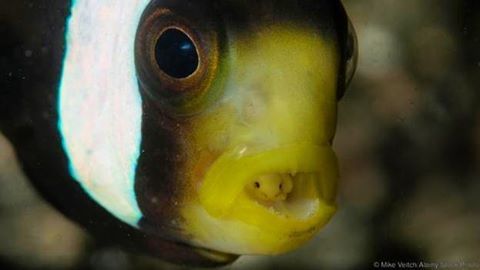
A saddleback anemonefish (Amphiprion polymnus) with a Cymothoa exigua in its mouth (Credit: Mike Veitch/Alamy Stock Photo) Tongue-eating louse (Cymothoa exigua) In January 2015, the internet retched in unison when a Nottingham mother opened a tin of tuna to find a pair of beady eyes peering back at her. The instigator of #tunagate turned out to be a Cymothoa exigua. It is a louse with a life so implausibly creepy, you couldn’t make it up. The parasite starts life as a male in search of a fish. Once it has found a suitable victim, it enters through the gills, crawls into the mouth, and undergoes a transformation. It plunges its legs into the base of the fishes’ tongue and gorges itself on their blood, growing enormously and turning female at the same time. Its eyes shrink and its legs expand. Eventually, the fish’s shrivelled tongue falls off, and the louse replaces it with its own body. From then on, the fish uses the parasite as a prosthetic tongue. The female mates with males living in the gills, giving birth to a brood of live male parasites that swim off to start the whole grisly process again.
0 notes
Video
youtube
A pair of saddleback clownfish (Amphiprion polymnus), also known as saddleback anemonefish, tend to their eggs at the dive site Bethlehem, between Caban Island and Marcaban Island near Anilao, Batangas, the Philippines.
Clownfish eggs are laid in a roughly circular patch stuck securely to the reef next to or slightly under the host sea anemone. The female lays the eggs and the male fertilizes them afterwards.
The parents continuously aerate the eggs with their mouths and fins to keep them oxygenated and clean as they grow. Any unhealthy eggs are picked off by the parents. The smaller male clownfish tends to do more of the work while the larger female parent defends the nest and her mate.
The eggs hatch in 7 to 10 days. As they develop the eyes become relatively large compared to the body. These eggs are quite mature and the larval clownfish babies probably hatch from the nest that night.
In the film Finding Nemo, the characters were intended to be a slightly different species: ocellaris clownfish, Amphiprion ocellaris, otherwise known as clown anemonefish.
The sea anemone in this footage is a Haddon's carpet anemone, Stichodactyla haddoni.
I shot this with a Panasonic GH4 in a Nauticam NA-GH4 housing. I used an Olympus M.Zuiko ED 12-50mm f3.5-6.3 EZ lens.
#clownfish#clownfish eggs#saddleback clownfish#Saddleback Anemonefish#sea anemone#panasonic gh4#Amphiprion polymnus#finding nemo#marine life#marine biology#underwater#scuba diving
4 notes
·
View notes
Video
youtube
Just keep swimming!
On a dive at Balanoy, otherwise known as "Secret Garden", in Anilao, The Philippines, dive guide Obet spotted a school of young saddleback clownfish, Amphiprion polymnus, in the shallows, fighting against the current.
This is the first video I have published that was shot with my new Panasonic GH4 camera in Nauticam housing. I was using the Olympus 12-50mm f/3.5-6.3 ED M.Zuiko EZ lens which has a macro mode for the close-up shots.
#clownfish#saddleback clownfish#saddleback anemonefish#Amphiprion polymnus#justkeepswimming#Anilao#scuba diving#underwater#tropical fish#marine life
6 notes
·
View notes